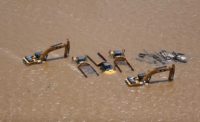Until recently, the list of what would be covered or excluded in a typical builders risk insurance policy was often a cut-and-dried affair. But these days, many construction and engineering companies are seeking a more flexible range of exclusions that had been used mostly on energy and industrial projects.
To meet the demand, insurers are writing policies that adopt language published by the London Engineering Group (LEG), an association that supports engineering, energy and construction liability underwriting markets. Of the three significant builders risk-related LEG defect-exclusion wordings, LEG 3 policy language is most frequently used in the U.S. Whether this exclusion finds a permanent, widespread place in U.S. construction risk management remains to be seen.
LEG 3
This exclusion by the London Engineering Group eliminates coverage only for costs to improve original materials, workmanship or design but keeps coverage for defect caused damage and rectification.
Builders risk insurance has a long history and covers losses or damage during the construction process. The basic policy usually includes fire and lasts at least a year or until the project is completed. While coverage can be expanded with endorsements to cover all kinds of risks, such as damage to equipment, defects in workmanship are generally excluded.
The rekindled interest in LEG 3 is part of a general reevaluation and reshaping of all the insurance provided to construction companies as the service delivery and risk landscape changes. Joseph Cellura, president of Allied World’s North American Casualty Division, says there has been a push to reevaluate exclusions on casualty insurance, which involves liability coverage. The push for LEG 3 in builders risk in some circumstances covers what is amended in the casualty policies, he said. Kris Feuerbacher, senior vice president of Allied World’s Inland Marine Division, which writes the builders risk insurance, says his company is open to additional coverage in its builders risk policies. He said it is always based on work with brokers, underwriting of contractors and taking account of U.S. case law, which mostly is determined state by state.
In contrast to typical builders risk policies, the three available LEG exclusions allow a range and can be narrower. LEG 3 is the narrowest and will allow the builders risk policy to cover the damage caused by faulty workmanship, materials or design errors but also the cost of accessing and correcting the defect itself. LEG 3 won’t cover the cost of improving the defective workmanship itself, however.
Still, policies with LEG 3 provisions can carry much steeper premiums, and the jury is out over whether they are always truly cost-effective compared to standard builders risk policies. In addition, the LEG 3 approach to insuring major projects is relatively untested in the U.S. legal system, making them somewhat of an unknown quantity should a policy with a LEG exclusion land in court. Some U.S. insurers are wary for that reason and wonder if London-based insurers are as mindful of the individual state law and labor conditions in the U.S. It has been suggested that, in principle, insuring defective workmanship is not a good idea in that it undercuts incentives for contractors to improve their quality control.
Limiting Litigation
Nevertheless, some insurance experts say adding a LEG exclusion to a builders risk policy can help to cut back on unnecessary and costly litigation sparked by differing interpretations over what is covered. “What LEG policies bring is a little more certainty to what’s covered and what’s not covered,” said Steven Coombs, a principal at LaGrange Park, Ill.-based risk management and commercial insurance consulting firm Risk Resources and co-author of a book on builders risk policies published in 2010 by the International Risk Management Institute. “Builders risk policies should be as broad as you can negotiate them,” said Coombs. If there is a loss, “the stakeholders don’t have the luxury of time to sit around and point fingers and litigate. They need to rebuild as fast as possible.”
LEG 2
LEG’s “consequence” defect exclusion eliminates overage of costs directly related to defects in material, workmanship or design and caps the costs of replacing or rectifying damage to a system or building.
The London Engineering Group was launched in the 1990s as a consultative organization by insurers and re-insurers active in the engineering market and, in particular, energy and operational power. Since then, the LEG approach to exclusions has become standard in both the U.K. and Europe.
The first experience U.S. insurers had with LEG exclusions were through policies written for global contractors and engineering companies working on projects in various cities and states across the country, noted Mark Katz, a New York City-based attorney. That has begun to change. More U.S. insurers are beginning to incorporate LEG 3 provisions into their policies to the point where contractors and engineering and design firms can probably get them by asking their brokers.
But it is hard to quantify how often these exclusions are used in the U.S. insurance market. For U.S. risks, they are more prevalent in policies issued by domestic insurers or domestic divisions of foreign insurers, Katz said. And LEG provisions are becoming fairly common in some U.S. sectors in projects over $100 million, such as the energy industry and, increasingly, in commercial real estate, said Risk Resources’ Coombs. But they are not very common in the $50-million to $100-million project range and still very rare on anything below $50 million, he said.
The stakeholders don’t have the luxury of time to sit around and point fingers and litigate. They need to rebuild as fast as possible.
— Steven Coombs, Principal, Risk Resources
“I don’t think it is coming from insurance companies, per se,” Coombs said. “They are reacting to increased demand from stakeholders in construction projects.”
The broader coverage offered by the LEG policy approach to coverage is a big reason for its growing use in the U.S. market, according to insurance experts. A recent International Risk Management Institute (IRMI) conference in Orlando, Fla., featured a presentation that compared LEG 3 coverage with traditional builders risk policies.
The traditional builders risk policy covers losses that happen by “accident or chance, not by design,” noted Lori Montoya, national construction property director at Zurich North America, in her IRMI presentation. Second, there must be physical damage in order for coverage to be triggered.
The only way builders risk policies have covered damage caused by faulty workmanship, materials or design is through an exception to the general exclusion for damage caused by the defect. Known as the “ensuing loss provision,” the exception spells out the potential fault or defect and “restores coverage for losses arising from the excluded peril [i.e., defect] if caused by a separate and independent peril,” Montoya wrote in her PowerPoint presentation.
Example No. 1: Defective Concrete
Montoya offered some examples of when builders risk policies fell short in making whole project owners and contractors. In one project plagued by defective concrete, the cost to repair the foundation was excluded by the “faulty or defective workmanship or material exclusion” in which “no separate physical loss or damage occurred.” In another case, a wall collapse was not covered due to the same exclusion because it did not cause any separate damage or physical loss.
By contrast, LEG 3, the broadest form of LEG coverage, pays to repair both the damage due to defective workmanship or design flaws as well as the cost of correcting the original source of the problem. It does not include coverage for costs to improve the original design, plan, specification, workmanship or material. The LEG3 extension is where “coverage is extensive,” says one insurance executive. That’s why it is requested.
Example No. 2: Bolt Failure
In one case involving an industrial building, designers “miscalculated the stress on the bolts that secured the roof beams together,” according to Montoya’s presentation. The bolts failed, causing the roofing panels to collapse as they were being fitted together and damaging “another unit on site.”
Under a LEG 3 policy exclusion, the insurer would cover the damage caused by the defects, including “property supported” by the defect and “loss, damage or costs incurred to access defective part,” Montoya noted.
LEG 1
LEG 1’s “outright” defect exclusion rules out coverage for defective work and materials and all loss or damage related to the system and building in which the system is housed.
Coombs offered another way to look at the difference: If a defective beam on a construction project causes a collapse, most U.S. builders risk policies would cover the “ensuing damage” but not the beam. A policy with LEG 3 language would cover both.
Still, with its much narrower exclusions, LEG 3 does provide broader coverage. Whether it always provides a better financial outcome for the policy-holding contractor or designer is not a settled point.
The more extensive coverage under a LEG 3 also comes at the cost of much higher premiums and higher deductibles, insurance experts say. The premiums on a LEG 3 policy on a big project might be as much as $250,000, compared to $100,000 for a builders risk policy, Coombs said.
As a result, there is no simple answer as to whether LEG 3 coverage always will provide a better financial outcome for a contractor or engineering firm compared to a traditional builders risk policy. While LEG 3 policies are seen by some as being less prone to litigation, there are also concerns about how LEG 3 policies will hold up in the U.S. court system. Further, there is the nagging question of whether indemnifying work defects removes incentives for contractors to improve.
By covering more, a LEG 3 policy removes some of the issues that typically spur litigation. And since exclusion for defective materials, design and workmanship is the “most litigated exclusion,” according to Risk Resources’ Coombs, eliminating lawsuits would be a worthy accomplishment.







Post a comment to this article
Report Abusive Comment